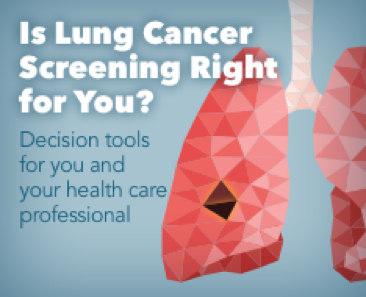By Cindy Brach, Senior Health Care Researcher, Center for Delivery, Organization, and Markets, Agency for Healthcare Research and Quality
The U.S. Preventive Services Task Force recommends lung cancer screening for older adults who are current or former heavy smokers and would be willing to have surgery if cancer were found. Screening can save lives, but is not risk free. In addition to exposure of radiation, 35.6% of those screened will have a false alarm and 1.8 percent will have a needless invasive procedure (e.g., a biopsy). As a primary care physician, you’ll want to help your patients make what may be a tough decision.
The decision will depend not only on a patient’s risk factors for lung cancer, but also on how she feels about the risk of an undetected cancer versus the higher risk of false-positive results and unnecessary biopsies, as well as the risk for the diagnosis and treatment of cancer that would otherwise not have become a threat to her health during her lifetime. Primary care is full of tough decisions, such as when to start a statin or whether to try medicine first or cognitive therapy for depression.
Clear Communication and Teach-Back
Explaining to patients what are the risks and benefits of their various choices in simple terms and checking that your explanation was clear enough to be understood is more difficult than it sounds. Health care professionals are so used to using the language of medicine, they don’t even realize it when they use words that not every patient will understand. Furthermore, many people have difficulty understanding risk – even saying, “ten percent of the time” can be confusing. Yet health care professionals often assume that patients understand when they shake their heads no when asked, “Do you have any questions?”
Here are some strategies you can use to improve communication:
- Obtain interpreter services if your patient doesn’t speak English very well and you are not fully competent in his or her language. Don’t try to get by with language skills that aren’t proficient.
- Use plain, non-medical language, slow down, and be specific and concrete. Don’t use vague words like “usually” or “likely” without more explanation.
- Encourage questions, listen carefully, and repeat important points.
- Use the teach-back method to confirm understanding by asking patients to explain in their own words what they think the risks and benefits are of each choice.
- Show high quality patient decision aids. Good decision aids are unbiased, often use graphics that make understanding easier, and help patients clarify their values.
Help Patients Make an Informed Choice
Many patients and families lack confidence when it comes to making medical decisions. They may be used to being told what to do or think it would be rude voice an opinion. Here are some strategies to promote informed decision making.
- Make it clear there is a choice and the choice is theirs. Even if there is only one viable treatment option, there is always the option of doing nothing.
- Engage patients and families. Acknowledge that although you are the expert about medicine, they are the experts about themselves.
- Get them to talk about their goals and values. Ask them about what’s most important to them (e.g., minimizing pain, living as long as possible) and what their main concerns are about the options.
- Talk about the cost of each option. While patients and clinicians may be uncomfortable broaching the topic, patients need to know what out-of-pocket costs they face in order to make an informed decision.
- Help patients make a choice by asking them to describe the pros and cons of each option and reflect how they fit with their goals and values.
Resources Available to Improve Your Skills
The Agency for Healthcare Research and Quality (AHRQ) has developed a self-administered training module that can help you have these conversations. AHRQ’s Making Informed Consent an Informed Choice: Training for Health Care Professionals teaches a total of 10 strategies for communicating clearly, presenting choices, and helping individuals make an informed choice. Health care professionals affiliated with The Joint Commission can take the 1.5 hour course for continuing education credit (CE or CME) on The Joint Commission’s learning management system. Visit: The Joint Commission — Improving the Informed Consent Process in the Hospital Setting.
A training module for facility leaders is also available for continuing education credit from The Joint Commission. AHRQ’s Making Informed Consent an Informed Choice: Training for Health Care Leaders addresses improvements that can be made on the systems level. Health care leaders who take the 1.5 hour module will learn:
- The principles of informed consent.
- How to craft a clear and comprehensive informed consent policy.
- What to consider when establishing libraries of easy-to-understand informed consent forms and high quality decision aids.
- How to remove communication barriers.
- The importance of establishing efficient workflows
Facilities that are not affiliated with The Joint Commission can obtain a copy of both modules to run on their own learning management system by emailing: healthliteracy@ahrq.hhs.gov.
Also available is the AHRQ Health Literacy Universal Precautions Toolkit. Use any of the 21 short tools to reduce the complexity of health care, increase patient understanding of health information, and enhance support for all patients. AHRQ’s Making Informed Consent an Informed Choice and the AHRQ Health Literacy Universal Precautions Toolkit both come with companion implementation guides.
